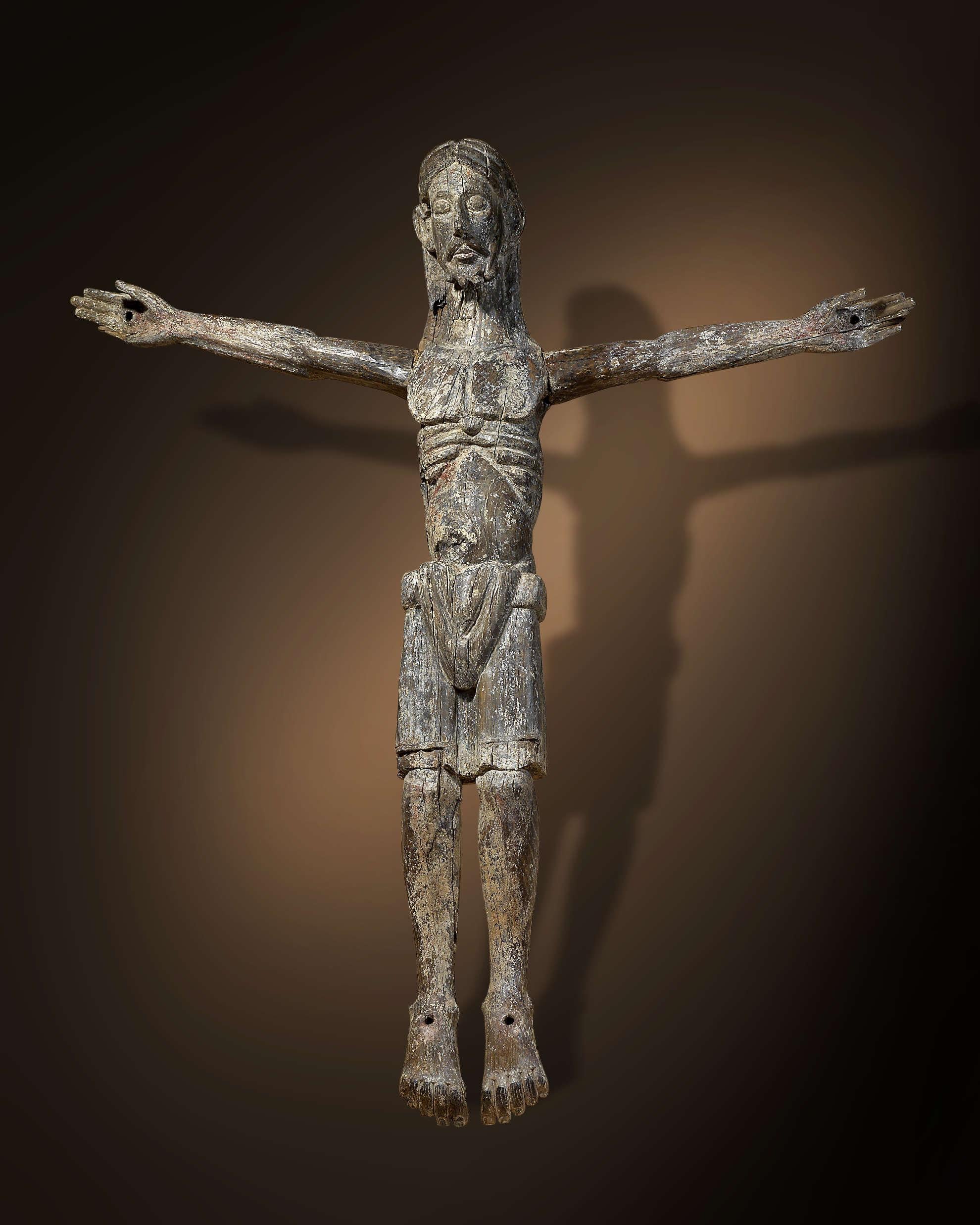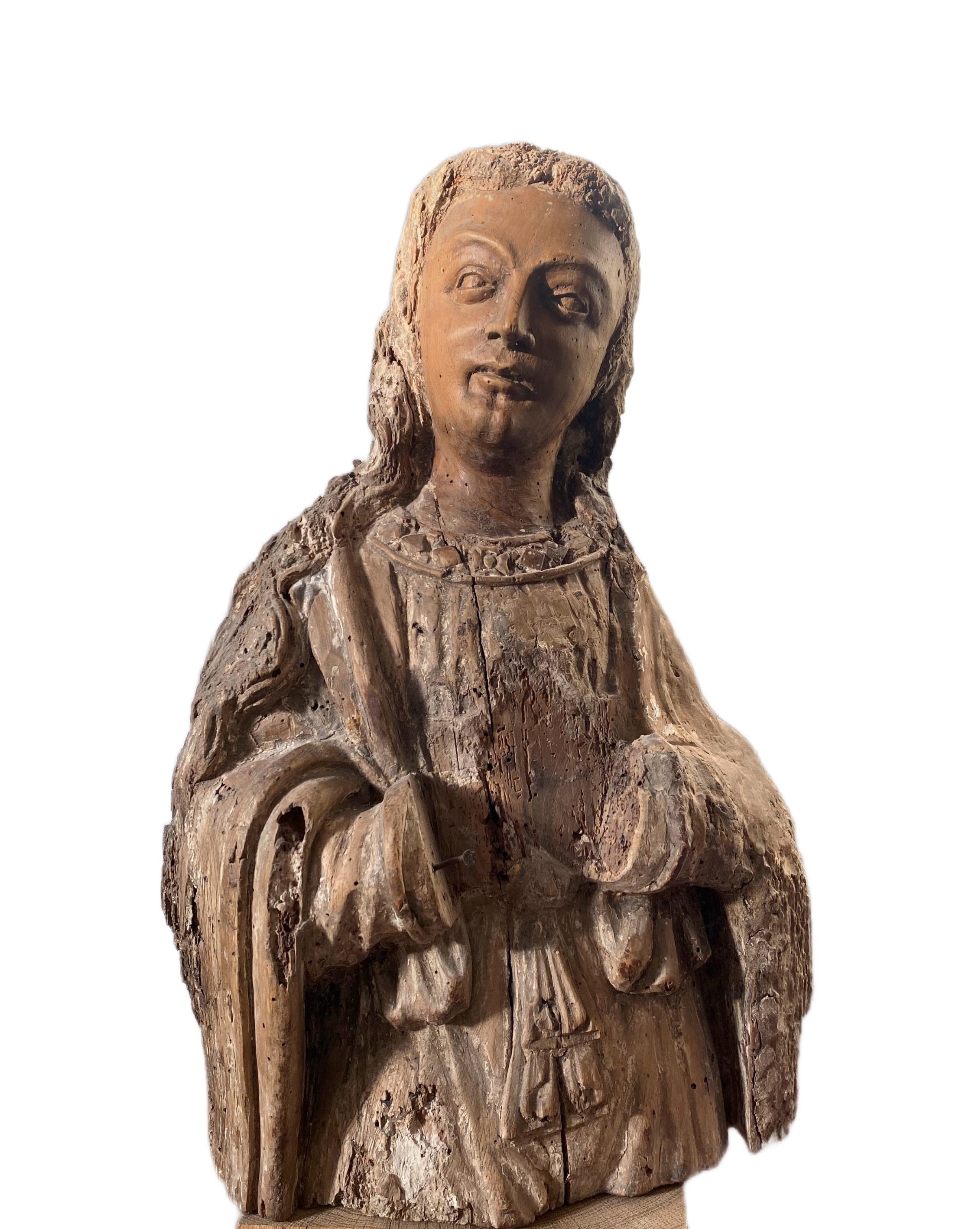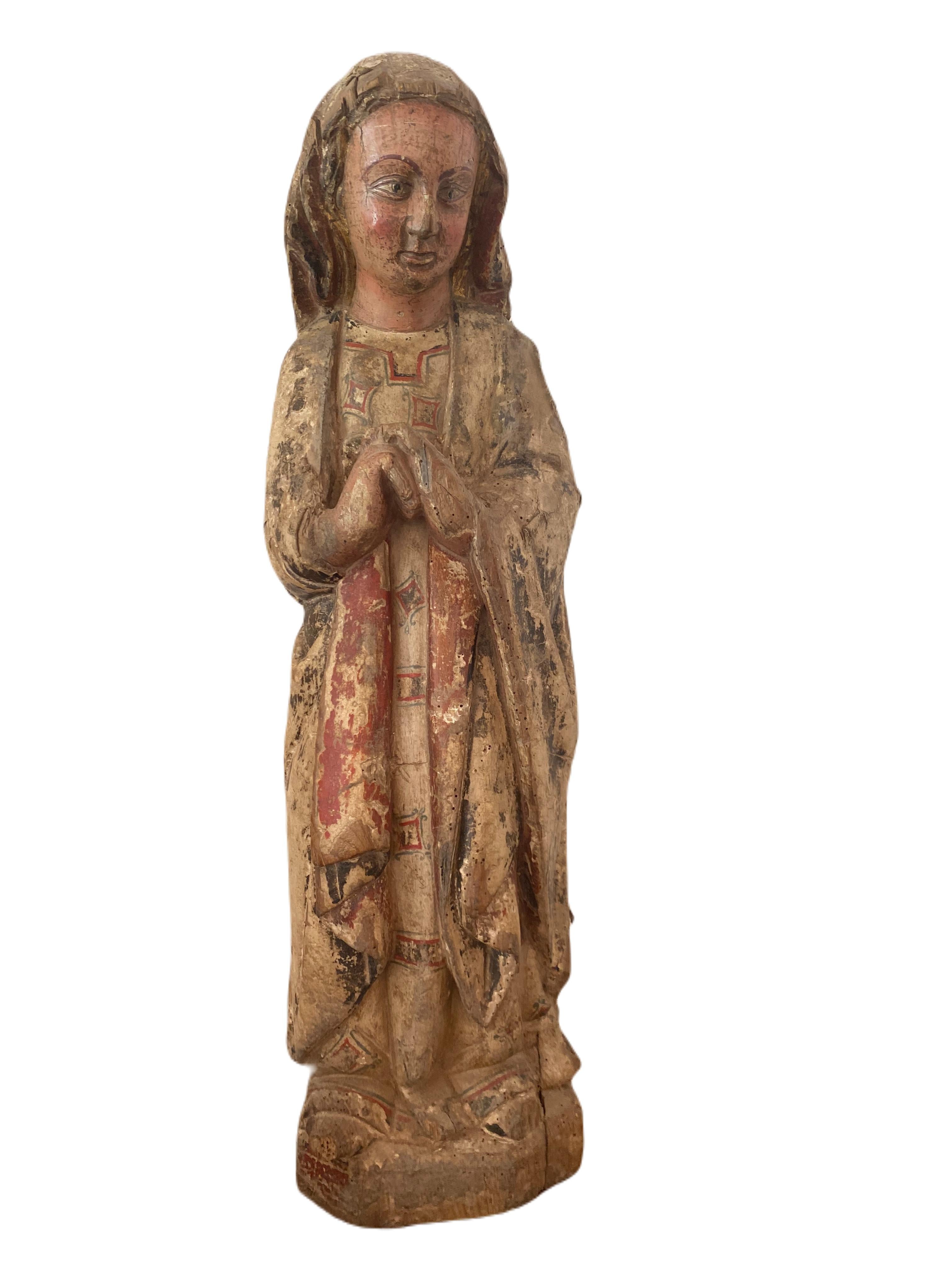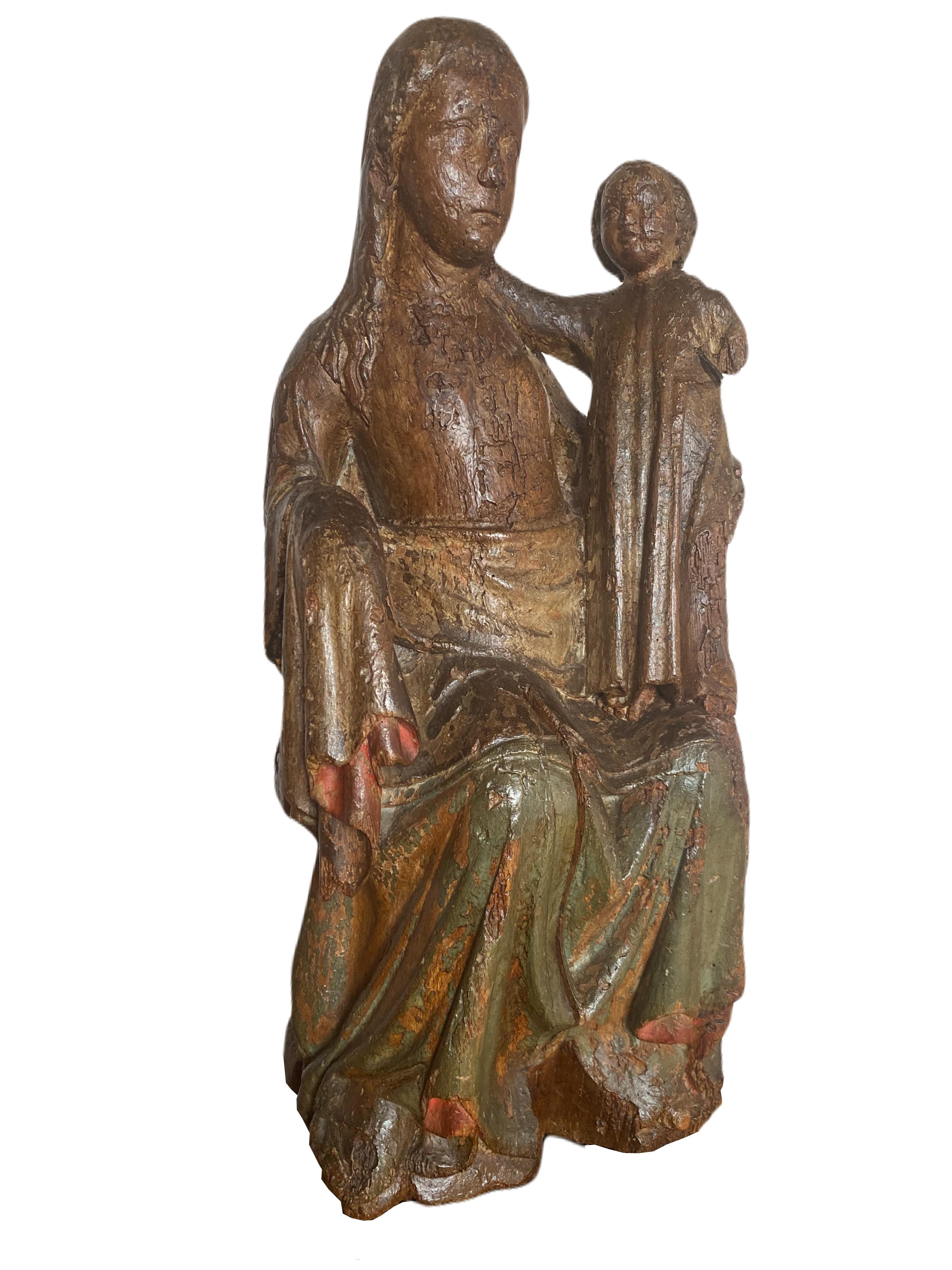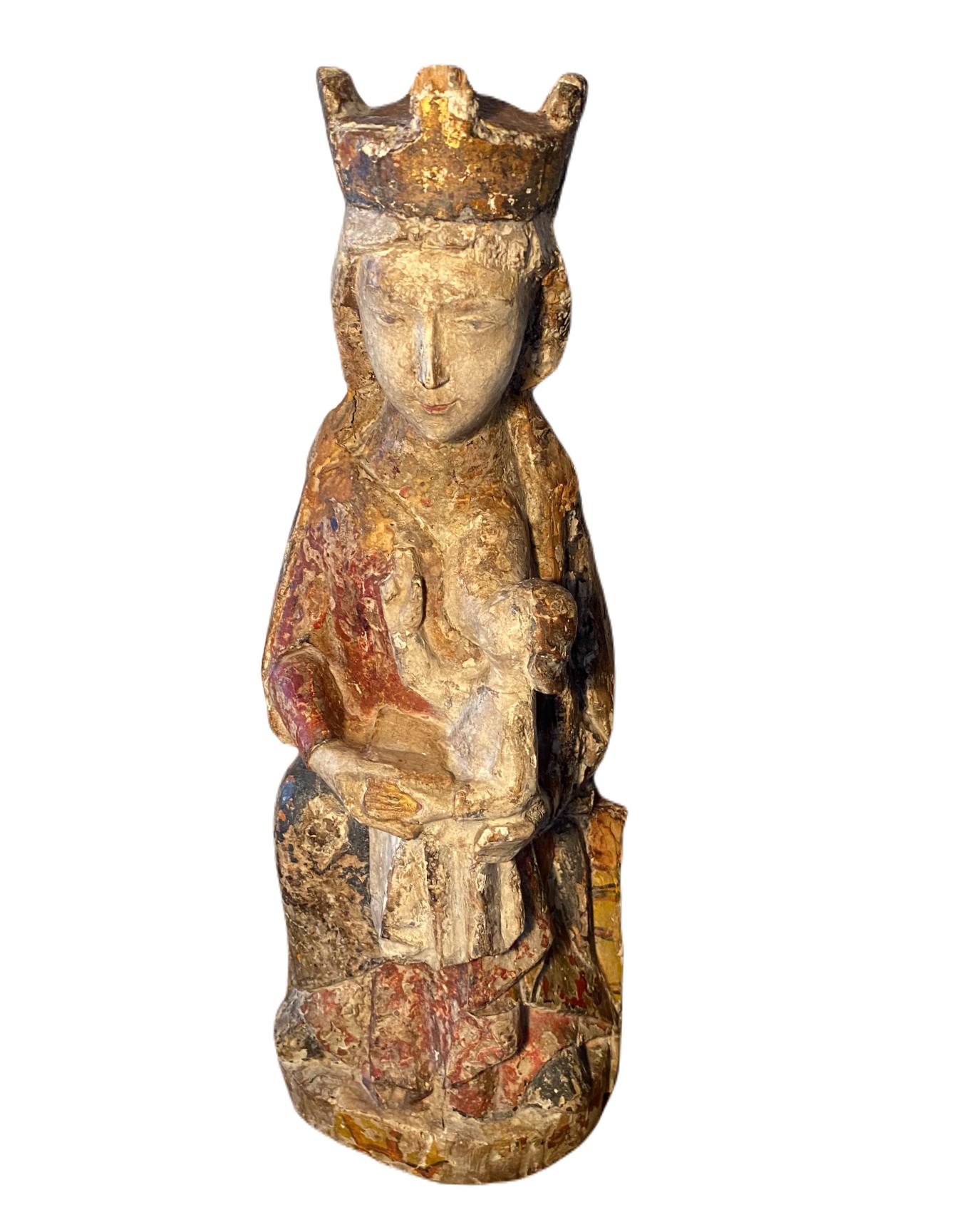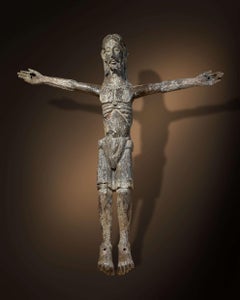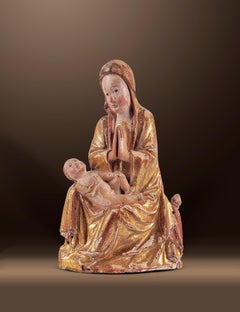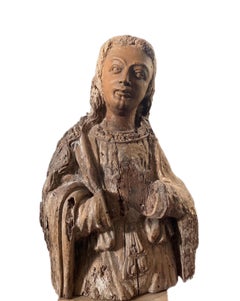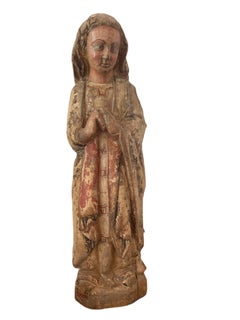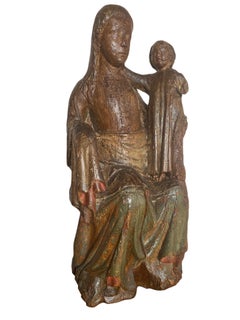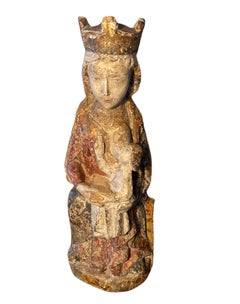Items Similar to Saint John the Evangelist
Want more images or videos?
Request additional images or videos from the seller
1 of 8
Saint John the Evangelist
About the Item
Saint John the Evangelist
Prague workshop from the circle of Master Theoderich
(mentioned from 1359 to 1368)
Around 1380/90
Carved & polychrome painted limewood
Height 88 cm
St. John – A masterpiece of Gothic sculpture in the Prague area
This impressive sculpture of St. John the Evangelist is an outstanding example of museum-quality Gothic art. It was created around 1380/90 in the circle of Master Theoderich in Prague – one of the leading artistic centers of Central Europe at the time – and is an extremely rare piece. Its art-historical significance lies not only in its masterful execution, but also in its association with one of the most fascinating workshops of late medieval art.
Master Theoderich and his artistic environment
Master Theoderich was a key figure in the Gothic art movement in Prague in the 14th century. As court painter to Emperor Charles IV, he had a decisive influence on the artistic decoration of St. Vitus Cathedral at Prague Castle. His influence extended far beyond panel painting: Theoderich’s workshop was most likely a lively center of collaborative creativity in which painters, sculptors and artisans worked closely together. It is quite conceivable that sculptors from his school also contributed to the architectural and sculptural masterpieces that defined the sacred and imperial representation of Prague.
St. John in detail
The sculpture shows John the Evangelist in an upright position, holding a banderole in his hands on which the words “Ave Maria” can be read. This greeting to the Virgin Mary is a central motif of medieval piety and emphasizes the role of the saint as a herald of the divine message.
Particularly striking are the characteristic stylistic features that reveal a close connection to the art of Master Theodoric: The short curls reaching down to the ears, with the central forelock sitting above the high forehead, are inevitably reminiscent of the figures that appear in the master’s panel paintings. The finely modeled facial features – the large, round eyes, the straight nose and the delicate mouth – reflect the naturalistic portrait style that became increasingly popular in Prague artistic circles in the late 14th century. The delicately reddened cheeks give the figure additional liveliness and warmth.
A remarkable comparison can be found in the depiction of St. Vitus in a window niche of the Chapel of the Holy Cross on Karlstein. There, too, the striking section of hair with a central mop of hair can be seen, as well as in the depiction of St. Louis of France above the south portal of the same chapel. The artistic design of the hair in thick, voluminous curls is a typical feature of Prague art from this period – impressively demonstrated by the so-called Madonna of Veveří.
John the Evangelist appears here, as is customary in the tradition of his portrayal, as a youthful and at the same time thoughtful figure – a symbol of spiritual depth and religious authority. This characterization points to his important role as the author of the fourth Gospel and as the visionary of the Revelation of John.
Garment and drapery as a reflection of Gothic fashion
The design of St. John’s robe corresponds to the fashion trends of the late 14th century: he wears a simple white tunic under a long, generously draped cloak. The cloak is fastened with an eye-catching clasp below the neck, which is decorated with a mirror – a symbol of his importance and dignity. The powerful folds of the cloak – from angular to softly curved bowl folds – testify to the sculptor’s masterful ability to bring movement and materiality to life. Particularly striking are the so-called “doughy” draperies, which characterize the “soft” or “international” style that flourished in Prague around 1400.
The Prague context – center of Gothic art
This sculpture fits into the stylistic development of depictions of St. John in the late Middle Ages: From earlier, often static, uniform forms to more individual and expressive figure images. The carefully designed clothing, the emphatically expressive facial features and the sculptural elaboration of the robe folds reflect the innovative power associated with Master Theoderic’s workshop environment.
Prague experienced an artistic heyday under the patronage of Emperor Charles IV. The city advanced to become a center of Gothic art, in which religious works not only served devotional purposes, but also underscored Prague’s growing claim to be a cultural and political metropolis. The close intertwining of piety, claim to power and artistic expression can be seen impressively in works such as this sculpture.
It is conceivable that the figure of St. John was created as part of the ambitious artistic endeavours of the Prague court – as part of a comprehensive program to stage the city as the new “Rome of the North”. Theoderich’s workshop played a central role in these efforts: with its high-quality devotional paintings and sculptures, it left a lasting mark on Prague’s sacred landscape. The figure of John the Evangelist with the banderole inscription “Ave Maria” fits perfectly into the context of Prague, where imperial power, religious devotion and artistic innovation were closely intertwined.
Literature
Jiří Fajt & Jan Royt, Magister Theodoricus. The court painter of Emperor Charles IV. The artistic decoration of the sacral rooms at Karlštejn Castle, Prague 1997.
Gustav E. Pazaurek, “Theoderich”, in: Allgemeine Deutsche Biographie 37, Leipzig 1894, pp. 708-710.
- Dimensions:Height: 34.65 in (88 cm)Width: 11.82 in (30 cm)
- Medium:
- Movement & Style:
- Circle Of:Master Theoderich (Czech)
- Period:
- Condition:
- Gallery Location:Wien, AT
- Reference Number:1stDibs: LU1143216293462
About the Seller
No Reviews Yet
Vetted Professional Seller
Every seller passes strict standards for authenticity and reliability
Established in 1986
1stDibs seller since 2019
- ShippingRetrieving quote...Shipping from: Wien, Austria
- Return Policy
Authenticity Guarantee
In the unlikely event there’s an issue with an item’s authenticity, contact us within 1 year for a full refund. DetailsMoney-Back Guarantee
If your item is not as described, is damaged in transit, or does not arrive, contact us within 7 days for a full refund. Details24-Hour Cancellation
You have a 24-hour grace period in which to reconsider your purchase, with no questions asked.Vetted Professional Sellers
Our world-class sellers must adhere to strict standards for service and quality, maintaining the integrity of our listings.Price-Match Guarantee
If you find that a seller listed the same item for a lower price elsewhere, we’ll match it.Trusted Global Delivery
Our best-in-class carrier network provides specialized shipping options worldwide, including custom delivery.More From This Seller
View AllCorpus Christi 1150/70
Located in Wien, Wien
Corpus Christi
around 1150/70
Southern France or Catalonia
carved oak wood
height 109 cm, width 96 cm
Remains of polychromy
Category
15th Century and Earlier Gothic Figurative Sculptures
Materials
Wood
Romanesque Madonna - 1175/80
Located in Wien, Wien
ROMAN MADONNA
“Sedes Sapientiae”
Auvergne
Around 1175/80
Pine wood
Polychrome remains
Height 40 cm
This depiction of the Madonna is a masterfully carved, extremely early figure made...
Category
15th Century and Earlier Gothic Figurative Sculptures
Materials
Wood
Sitting Madonna
Located in Wien, Wien
Sitting Madonna
Central Italy/Tuscany or Marche
Around 1420
Poplar wood carved
Original version
Height 31 cm
Charming Madonna sculpture from the heyday of the Soft or International...
Category
15th Century and Earlier Gothic Figurative Sculptures
Materials
Wood
Late Gotic Relief "Adoration of the Magi"
Located in Wien, Wien
LATE GOTIC RELIEF “Adoration of the Magi
Lower Rhine
Around 1500
Oak wood, plastically carved
Original, polychrome version
Height 51 cm, widt...
Category
16th Century Gothic Figurative Sculptures
Materials
Wood, Oak
CRESCENT MOON MADONNA
Located in Wien, Wien
Master in the circle of Michael Pacher
(Mühlen ca. 1435 - 1498 Salzburg)
Salzburg
Around 1480
Carved limewood
Old polychrome version
Height 118 cm
This Madonna is an outstanding ex...
Category
15th Century and Earlier Gothic Figurative Sculptures
Materials
Wood
$168,000
Virgin and Child
Located in Wien, Wien
OUTSTANDING MADONNA
Bavaria
Around 1515/20
Lime wood carved
Original, polychrome version
Height 60 cm
This masterfully carved, full-round Madonna was created around 1515-20 in...
Category
16th Century Medieval Figurative Sculptures
Materials
Wood
You May Also Like
Gothic Renaissance wooden sculpture: bust of a young Saint or Angel
Located in Norwich, GB
This young saint or angel has suffered over the centuries, but his spirit has not been broken - and miraculously, his beautiful face has remained intact. With a gentle face and an al...
Category
15th Century and Earlier Gothic Figurative Sculptures
Materials
Wood
Polychrome Virgin of the Annunciation - Catalonia
Located in PARIS, FR
Large catalan Virgin of the Annunciation in polychrome wood. Our Virgin is represented in the phase of the Conturbatio, Mary expresses her amazement a...
Category
15th Century and Earlier Gothic Figurative Sculptures
Materials
Wood
Vierge en majesté mosane. Sedes Sapientiae.
Located in PARIS, FR
Grande Vierge à l'Enfant en chêne de la fin du 13ème siècle ou début du 14ème siècle. La plastique des visages et du Christ évoque le 13ème siècle (le visage de la Vierge évoque le visage de la Sedes Sapientiae...
Category
15th Century and Earlier Gothic Figurative Sculptures
Materials
Wood
Vierge en majesté. Catalogne française - Maria Lactans
Located in PARIS, FR
Rare Vierge à l'Enfant en bois polychrome de tradition romane, région du Fenouillèdes, représentant une Virgo Lactans. Avant cette découverte, seules 3 vierges allaitantes médiévales...
Category
15th Century and Earlier Gothic Figurative Sculptures
Materials
Wood
Pilgrim polychrome stone figure
Located in PARIS, FR
Pilgrim or saint Jacques figure in sculpted and polychromed limestone. He holds a calabash in his left hand. He probably held the pilgrim's staff in his missing right hand. Very beau...
Category
15th Century and Earlier Gothic Figurative Sculptures
Materials
Limestone
Emma
Located in Rye, NY
The piece is based on Australian super-model Emma Champdaloup who really has those planar features, soaring cheekbones and intense gaze. I saw in the piece an archetypal female powe...
Category
2010s Gothic Figurative Sculptures
Materials
Marble, Steel
Price Upon Request
